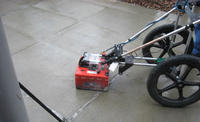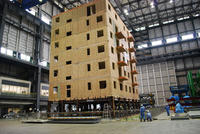-
Bridges get a quick check-up with new imaging technique

EPFL engineers have developed a new imaging technique which allows engineers to see the insides of massive concrete bridges; much like a sonogram, this technique provides quick, easy-to-interpret images, so that the health of these expensive structures can be assessed and monitored
-
-
California quake test shows promise of new building code

Researchers place a model hospital on a shake table to assess the structure’s ability to withstand earthquake; in accordance with California latest building code, base isolators, which are rubber bearings intended to absorb the shock of the motion, were installed underneath the structure; the hospital passed the 6.7-magnitude and 8.8-magnitude tests with flying colors
-
-
Water vulnerability in U.S. border region
The Arizona-Sonora region has been called the front line of ongoing climate change, with global climate models projecting severe precipitation decreases and temperature increases coupled with vulnerability from urbanization, industrialization and agricultural intensification
-
-
Robust nanosponges soak up oil again and again
Researchers show that nanotube blocks hold promise for environmental cleanup following oil spills or other disasters; the robust sponge can be used repeatedly and stands up to abuse; a sample nanosponge remained elastic after about 10,000 compressions in the lab; the sponge can also store the oil for later retrieval
-
-
Insider: H5N1 studies publication vote biased, unbalanced
In late March, the National Science Advisory Board for Biosecurity (NSABB) reversed its earlier recommendation, made in December 2011, against full publication of two studies describing lab-modified H5N1 viruses with increased transmissibility in mammals; the recommendation was based on fears that the findings would help terrorist design effective bioweapons; a NSABB board member says that the March reversal of the December recommendation was the result of a bias toward finding a solution that was more about getting the government out of the current dilemma than about a careful risk-benefit analysis
-
-
Ion stream to clean up Earth orbit, deflect asteroids
One of the legacies of the space age is an ever-more-crowded near-Earth orbit, where all manner of long-abandoned human-made objects loiter, posing danger to newer space platforms; scientists want to develop a magnetized-beam plasma propulsion device which would be deployed in Earth orbit and which would use a focused ion stream to push dead satellites and other debris toward Earth’s atmosphere, where they would mostly burn up on re-entry; the device could also be used to deflect menacing Earth-bound asteroids hurtling toward Earth
-
-
Diet change required to curb most potent greenhouse gas
N2O is the third highest contributor to climate change behind carbon dioxide (CO2) and methane (CH4), but it poses a greater challenge to mitigate as nitrogen is an essential element for food production; it is also the most potent of these three greenhouse gases as it is a much better absorber of infrared radiation
-
-
Rhinoceros beetles foretell future of flapping-wing design

Researchers launch a quantitative investigation of aerodynamics and wing kinematics in rhinoceros beetle flight in order to shed new light on the evolution of flapping flight in nature; experimental study of the aerodynamic performance of beetles in forward/hovering flight will provide insight into designs for efficient and stable flapping-wing micro aerial vehicles
-
-
In environmental disasters, families experience conflict, denial, silence
Environmental disasters affect individuals and communities; they also affect how family members communicate with each other, sometimes in surprising ways; the researchers say that the findings were, in some ways, counterintuitive
-
-
£5 million investment in U.K. rail technology, business innovation
The U.K. government is leading on an investment of £5 million to accelerate business innovation and growth in the U.K. rail industry, using the funds to support the development of technologies to address technological and business challenges
-
-
Simulations helps overcome design challenges
Simulation software can pull volumes of complex data beyond simple measurements (think comparative load or stress tolerances) and layer that information into images; simulation can show how a bridge will perform based on how it is used, the conditions around it, its design, materials, and even variables such as the position of a joint — before a single component is manufactured or ground is broken
-
-
Southern sea levels rise dramatically
Sea levels have risen about twenty centimeters in the South West Pacific since the late nineteenth century, a new scientific study shows
-
-
Most states in U.S. unprepared for growing water threats to economy, health
Only nine states in the United States have taken comprehensive steps to address their vulnerabilities to the water-related consequences of changes in climate — rainfall events which increase flooding risks to property and health change, and drought conditions which threaten supply for municipalities, agriculture, and industries — while twenty-nine states are unprepared for growing water threats to their economies and public health
-
-
Formation of hate groups associated with presence of big-box stores
In a new research, economists say that the presence of big-box retailers, such as Wal-Mart, K-Mart, and Target, may alter a community’s social and economic fabric enough to promote the creation of hate groups; the researchers say that the number of Wal-Mart stores in a county is more significant statistically than factors commonly regarded as important to hate group participation, such as the unemployment rate, high crime rates, and low education
-
-
DARPA offers $2 million in prizes for Robotic Challenge winners
DARPA is seeking hardware, software, modeling, and gaming developers to link with emergency response and science communities to design robots capable of supervised autonomous response to simulated disaster
-
More headlines
The long view
New Technology is Keeping the Skies Safe
DHS S&T Baggage, Cargo, and People Screening (BCP) Program develops state-of-the-art screening solutions to help secure airspace, communities, and borders
Factories First: Winning the Drone War Before It Starts
Wars are won by factories before they are won on the battlefield,Martin C. Feldmann writes, noting that the United States lacks the manufacturing depth for the coming drone age. Rectifying this situation “will take far more than procurement tweaks,” Feldmann writes. “It demands a national-level, wartime-scale industrial mobilization.”
How Artificial General Intelligence Could Affect the Rise and Fall of Nations
Visions for potential AGI futures: A new report from RAND aims to stimulate thinking among policymakers about possible impacts of the development of artificial general intelligence (AGI) on geopolitics and the world order.
Smaller Nuclear Reactors Spark Renewed Interest in a Once-Shunned Energy Source
In the past two years, half the states have taken action to promote nuclear power, from creating nuclear task forces to integrating nuclear into long-term energy plans.
Keeping the Lights on with Nuclear Waste: Radiochemistry Transforms Nuclear Waste into Strategic Materials
How UNLV radiochemistry is pioneering the future of energy in the Southwest by salvaging strategic materials from nuclear dumps –and making it safe.
Model Predicts Long-Term Effects of Nuclear Waste on Underground Disposal Systems
The simulations matched results from an underground lab experiment in Switzerland, suggesting modeling could be used to validate the safety of nuclear disposal sites.
